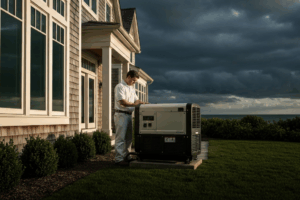What Are the NEC Requirements for Electrical Receptacles?
NEC Receptacle Requirements: A Professional’s Guide Introduction
Strict adherence to the NEC receptacle requirements is a foundational aspect of professional electrical work. As licensed electricians, ensuring compliance with the National Electrical Code (NFPA 70) for their installation is paramount for safety, functionality, and compliance. This article provides a comprehensive overview of the key NEC requirements for electrical receptacles, covering their placement, types, and the critical safety and installation protocols that every professional must follow. Understanding and correctly applying these rules prevents common violations, enhances user safety, and ensures the long-term integrity of the electrical system.
Mastering NEC Receptacle Installation for Safe and Compliant Electrical Systems
To achieve safe and NEC-compliant electrical installations, electricians must expertly apply NFPA 70 receptacle requirements, including proper placement, GFCI/AFCI protection, and dedicated circuits. By following these standards and prioritizing electrical safety, professionals can prevent hazards like shocks, fires, and equipment damage, ensuring reliable and code-compliant systems for homes and businesses.
Key NEC Requirements for Receptacle Installation
The NEC provides detailed rules regarding the type and location of receptacles to prevent hazards and improve usability.
- General Spacing Requirements: The primary rule, found in NEC 210.52(A)(1), dictates that wall space in a dwelling unit must have a receptacle outlet installed so that no point along the floor line in any wall space is more than 6 feet, measured horizontally, from a receptacle outlet in that space. This ensures convenient access and reduces the use of extension cords.
- Small Appliance and Laundry Circuits: The NEC mandates dedicated 20-amp, 120-volt branch circuits for kitchen and laundry areas to handle high-demand appliances. For example, the kitchen countertop requires a receptacle outlet for every 2 feet of counter space (receptacle receptacle). A laundry area must have at least one dedicated receptacle.
- Outdoor and Basement Receptacles: Per NEC 210.52(E), at least one outdoor receptacle outlet must be installed at the front and back of a one- and two-family dwelling. Basements, garages, and accessory buildings also have specific requirements. These locations and others must be protected by Ground-Fault Circuit Interrupters (GFCIs).
- GFCI and AFCI Protection: The NEC requires installing ground fault circuit interrupter outlets in specific locations to protect against electrical shock, particularly where water may be present. These locations include bathrooms, kitchens, garages, outdoors, and basements. Arc-Fault Circuit Interrupter (AFCI) protection is required for most dwelling unit outlets to protect against arc-fault fires.
Essential Safety Protocols
Electrical work, especially the installation of receptacles, requires strict adherence to safety protocols to mitigate risks.
- De-energize Circuits: The most critical step is to always de-energize the circuit before beginning work. Use a non-contact voltage tester to confirm the circuit is de-energized.
- Lock Out/Tag Out (LOTO): Implement proper LOTO procedures to prevent accidental re-energization of the circuit by others. This is a core tenet of NFPA 70E, the standard for electrical safety in the workplace.
- Use of PPE: Wear appropriate Personal Protective Equipment (PPE) at all times, including safety glasses and insulated gloves, especially when working on a circuit that is potentially energized or near an active panel.
- Conductor Management: When installing receptacles, ensure conductors are properly stripped and that terminals are tightened to the correct torque value specified by the manufacturer. Avoid tying cables together so tightly that it damages insulation.
Advanced Considerations and Troubleshooting
Beyond basic installation, a professional electrician must consider advanced applications and be prepared to troubleshoot common issues.
- Grounding and Bonding: All receptacles must be properly grounded to the electrical system’s grounding electrode system. A ground wire ensures that fault current can safely return to the source, tripping the overcurrent protective device.
- Dedicated Circuits: High-demand appliances, like refrigerators, freezers, and microwaves, often require dedicated circuits to prevent overloading and nuisance trips. The wire ampacity chart and correct wire sizing are essential here.
- Voltage Drop: On long runs, voltage drop can affect equipment performance. Use the wire ampacity chart in conjunction with voltage drop calculations to select a wire gauge that maintains proper voltage.
- Surge Protection: Consider the installation of a protective surge device at the panel to safeguard the entire home’s electrical system from transient over voltages.
- Accessible Definition: Understanding the accessible definition is crucial for both installation and troubleshooting. An accessible receptacle or component means it is not guarded by a locked door or other means, allowing for easy access for maintenance.
Conclusion
The proper installation of electrical receptacles according to NFPA 70 is a cornerstone of safe and compliant electrical work. By understanding the detailed requirements for placement, GFCI/AFCI protection, and dedicated circuits, electricians can deliver systems that are both user-friendly and hazard-free. Always prioritize safety by de-energizing circuits and following NFPA 70E protocols. A thorough grasp of these principles not only ensures a successful inspection but, more importantly, guarantees the safety of the occupants and the reliability of the electrical installation.
Take the next step in your professional growth! Visit Expert CE (https://expertce.com/) for all your continuing education needs.
Continuing Education by State
Select your state to view board-approved continuing education courses and requirements:
Disclaimer: The information provided in this educational content has been prepared with care to reflect current regulatory requirements for continuing education. However, licensing rules and regulations can vary by state and are subject to change. While we strive for accuracy, ExpertCE cannot guarantee that all details are complete or up to date at the time of reading. For the most current and authoritative information, always refer directly to your state’s official licensing board or regulatory agency.



